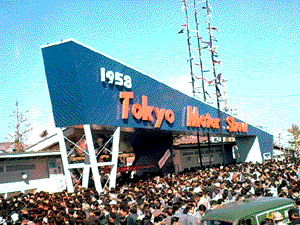 |
In 1958, due to construction of a subway and underground parking lot near Hibiya Park, the show was shifted to Korakuen Bicycle Racing Track. The 6th Show onward was already planned for Harumi Fairground. The 5th Show suffered from heavy rain. The lawn on the lower ground was covered with water and trampled by a crowd of 519,400. Thus that year turned out to be the "Muddy Show." Since the exhibition area was about twice as large as Hibiya, fees and construction expenses expanded. These were recouped by raising the admission fees by ¥10 to ¥30.
This JMIF-organized show was provided with a "Rendezvous Plaza" and Technical Center (sponsored by Society of Automotive Engineers of Japan, Inc.) aimed at explaining the technology of domestic cars to the public. At the main entrance to the Show was an Automobile Consulting Office, which drew an average of 300 visitors a day. The PR Center appealed for "Enhanced traffic morality" to cooperate with the Ministry of Transport which was troubled by "Kamikaze Taxis." This was also a new scheme.
The number of exhibitors increased to 302, while the number of exhibits decreased to 256. This seemed to be the result of focusing on popular models. There were many innovative models exhibited. A midget car, "Subaru 360" attracted much attention amid the people s car boom. Also popular were the 1.5-liter Toyota Crown prototype, equipped with the world s smallest diesel engine, the Prince 1900 production model, and a unique car, "Mikasa Touring" equipped with a 600cc engine and torque converter. Topical trucks included the Mazda Romper, Kurogane Mighty, Daihatsu Vesta, and Cripper, a medium truck put out by Fuji Precision Machinery. As for trucks, the conversion of 2- and 3-wheeler makers to 4-wheeler manufacturers was conspicuous. Japan s first bus equipped with air suspension system, developed by Minsei Diesel Engineering, also attracted much attention.
This was the year Toyota, Nissan, and Fuji Precision Machinery started full-scale exports of the Crown, Datsun, and Skyline to the U.S. At the Australian Rally -- famous as the world s roughest race, Datsun 1000 (Fuji) won the championship in its class. Crown also competed. Thus, Japanese cars were beginning to be known overseas. Visitors to the Motor Show included a few foreigners, another new feature at this Show.
|